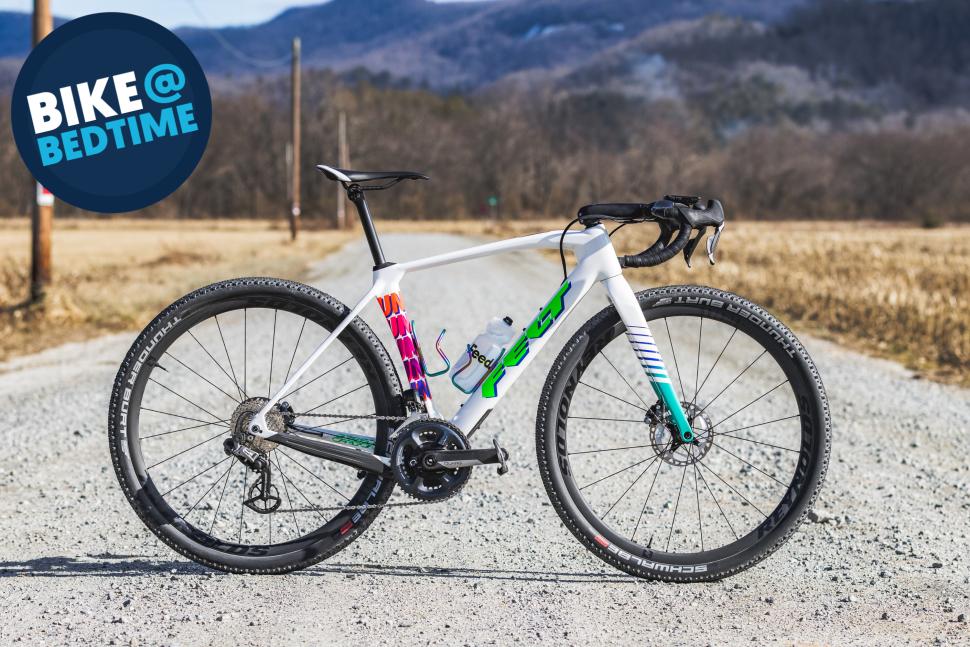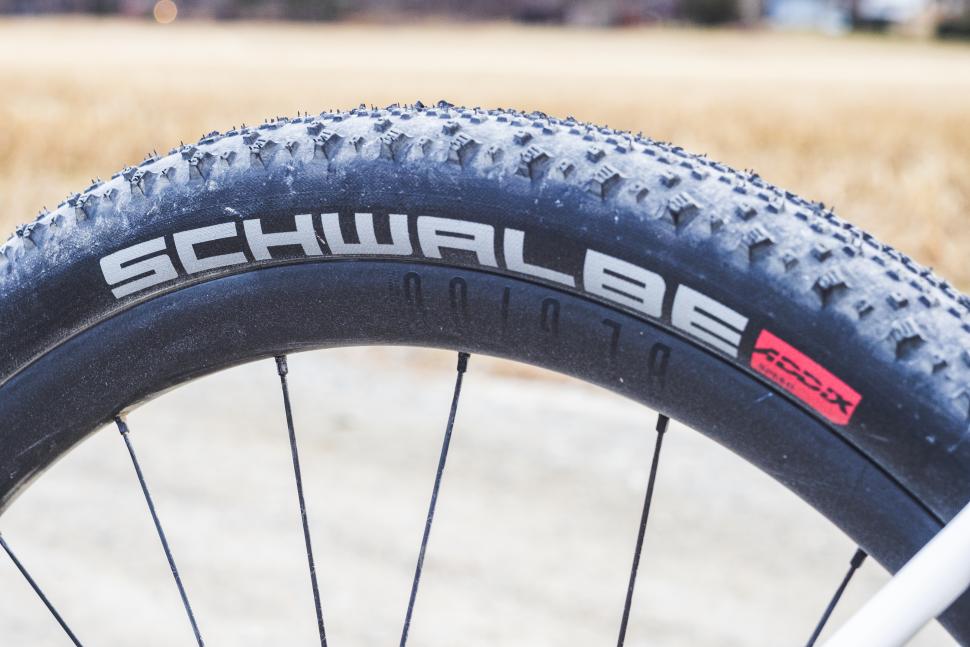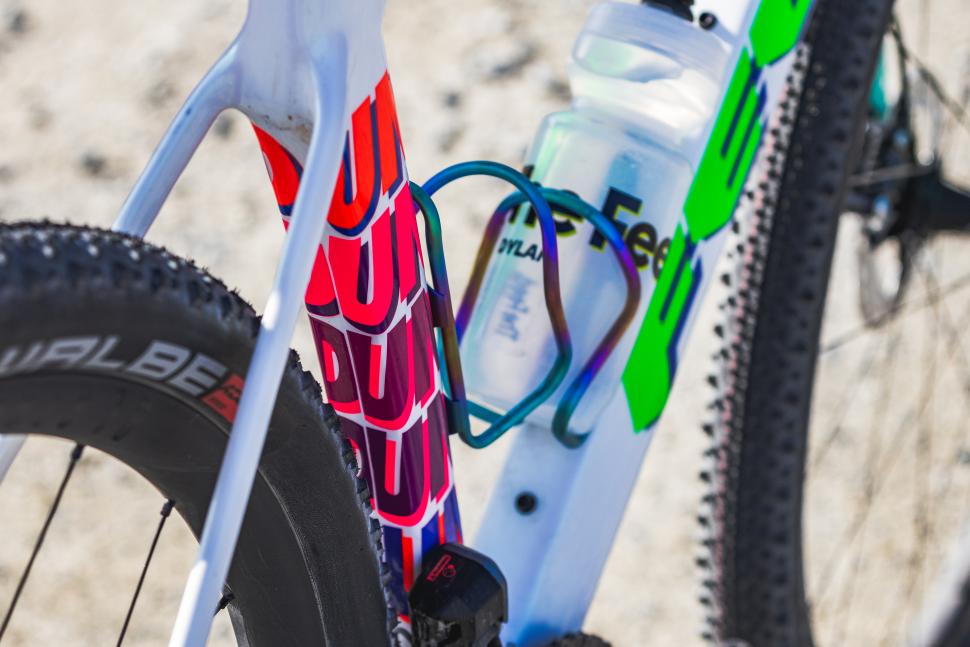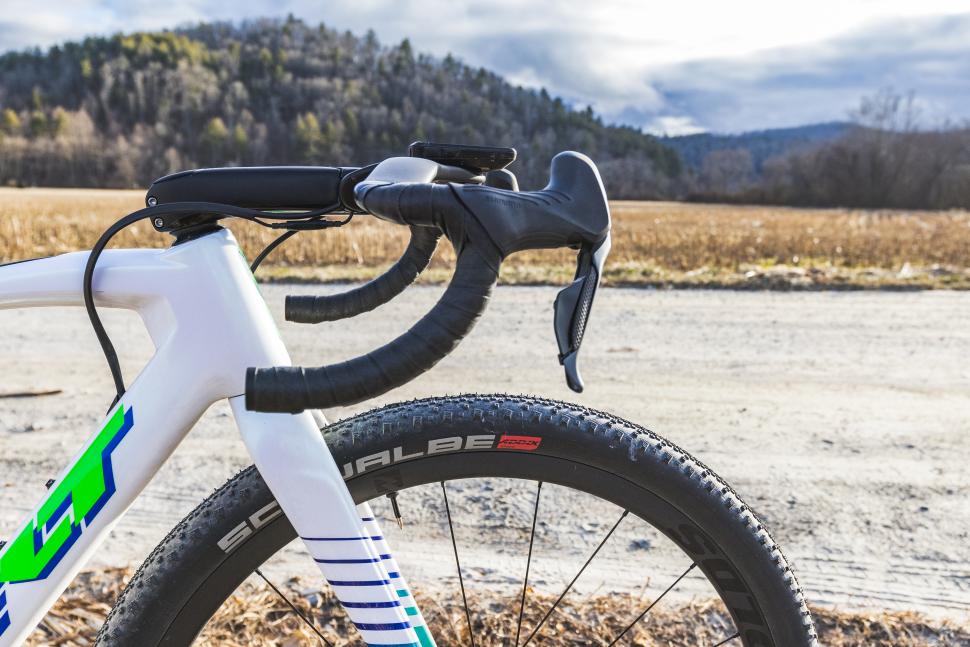- News
- Reviews
- Bikes
- Components
- Bar tape & grips
- Bottom brackets
- Brake & gear cables
- Brake & STI levers
- Brake pads & spares
- Brakes
- Cassettes & freewheels
- Chains
- Chainsets & chainrings
- Derailleurs - front
- Derailleurs - rear
- Forks
- Gear levers & shifters
- Groupsets
- Handlebars & extensions
- Headsets
- Hubs
- Inner tubes
- Pedals
- Quick releases & skewers
- Saddles
- Seatposts
- Stems
- Wheels
- Tyres
- Tubeless valves
- Accessories
- Accessories - misc
- Computer mounts
- Bags
- Bar ends
- Bike bags & cases
- Bottle cages
- Bottles
- Cameras
- Car racks
- Child seats
- Computers
- Glasses
- GPS units
- Helmets
- Lights - front
- Lights - rear
- Lights - sets
- Locks
- Mirrors
- Mudguards
- Racks
- Pumps & CO2 inflators
- Puncture kits
- Reflectives
- Smart watches
- Stands and racks
- Trailers
- Clothing
- Health, fitness and nutrition
- Tools and workshop
- Miscellaneous
- Buyers Guides
- Features
- Forum
- Recommends
- Podcast
feature
 dylan johnson felt breedcarbon bikeatbedtime (1)
dylan johnson felt breedcarbon bikeatbedtime (1)Dylan Johnson's Felt Breed Carbon — a controversial gravel race bike with... mountain bike tyres
American pro gravel racer and YouTuber Dylan Johnson revealed the gravel bike he'll be racing on in 2024 earlier this week, and it's definitely opened a can of worms in the comments section of his social media feeds and beyond.
Numerous concerned Johnson fans are pondering potential lost watts because he's chosen not to go with full internal cable routing, while others are mortified by the saddle fore-aft. With this new bike, Johnson has waved goodbye to Factor as his bike sponsor and will now be seen aboard a custom-painted Felt Breed Carbon. This is hardly surprising given the bike has been made for fast gravel racing, but it's Johnson's setup that has sparked a lot of discussion about... well, pretty much everything on this bike.
In his Instagram post introducing the new race weapon, Johnson didn't say much about the bike. But when we contacted him he told us the main selling point for riding the Breed Carbon is that it's one of just a few gravel bikes on the market that is race-focussed and can fit 50mm (or wider) tyres.
"The industry has gravel tire size wrong", says Johnson.
"Whenever I test tires I always come to the same conclusion, wider is faster and the current crop of lightweight XC mountain bike tires are usually faster than their gravel counterparts. I’m not saying I’m never going to use a narrow gravel tire again but I find myself gravitating towards wider and wider tires every year."
Johnson adds that he won't rule out swapping to narrower offerings later in the season, depending on the conditions.
The tyres on Johnson's bike are Schwalbe Thunder Burt 2.1in (51mm) when measured on the Reynolds G700 rims, which are 25mm wide internally.
"They have been tested to be one of the lowest rolling resistance off-road tires on the market, lower than almost every gravel tire available. Again, I'm just testing them for now and may opt for something different come race season", Johnson says.
It's evident that this bike was launched in 2022, just before the 'lets-integrate-everything' home mechanic's nightmare started filtering through to endurance road and gravel bikes, because you can see the cables looping into the frame at the front of the bike ("Those exposed cables are costing you .274 watts," one commenter said).
While Johnson is an advocate for more tyre width, when it comes to cargo mounts he's very much in the less is more camp. The Breed Carbon doesn't come with any 'unnecessary' mounts – there are four bottle mounts and that's it. No fork mounts, no top tube mounts… nada.
The speeds in elite gravel racing have increased every year, so aerodynamics have started to play a bigger role in the sport. The Felt bike that Johnson is riding is a testament to this, crafted with aero-shaped tubes and the Coefficient RR (Road Race) Carbon Handlebar. It's narrow and slippery-looking and looks like it will allow Johnson to adopt the 'puppy paws' position at races like the Unbound, where aero bars are now banned for pro riders.
One of the contested aspects of Johnson's new bike is the way it's been set up. Seeing super long stems and forward-slammed saddles is hardly uncommon in the gravel scene, with Lachlan Morton's Leadville setup just one example. Like the other pros, Johnson seems to have thrown out the bikefitting handbook and gone for what works for him. That means the aero handlebar is paired with a very long Enve stem, which seems to be alleviated by a dramatically forward-placed saddle. Is it comfy?
Johnson says: "The saddle and bar position of the bike is a bit jarring to look at, I know, but I run my saddle that far forward just because that's where it needs to be for my femur/tibia dimensions. The stem is a 140mm enve aero stem and the bars are 36cm Coefficient RR. This is for getting into an aero position.
"If I was prioritizing comfort I'd probably put a 110mm or 120mm stem on. The bars actually put the hoods in the same position as a normal bar would even though they are oddly shaped. I'm just experimenting with them now and they may or may not be on my bike come race season."
The geometry of the Breed Carbon is also suspension and dropper compatible, which means that for those gravel races that are titled mountain bike races, Johnson could throw on a suspension fork. Finishing up the bike, Johnson has a Shimano GRX 810 gravel drivetrain spiced up with a CeramicSpeed rear derailleur, Quarq Dzero crankset (172.5mm cranks, 50/34t chainrings), Silca bottle cages and a Wahoo computer.
"I prefer Shimano over Sram for gravel because Shimano's chains are slightly more efficient. Their 2x also works better in my opinion and 2x is more efficient than 1x as well," Johnson says.
It's likely that once the season starts we will see Johnson's setup slightly altered, but as it stands it already looks pretty fast.
How do you think Johnson will do on his new Felt in the 2024 gravel season? Let us know your thoughts about this bike in the comments below and also, remember to check out our previous Bike at Bedtime features.
[Photos courtesy of Taylor Farman]
Latest Comments
- slc 0 sec ago
There is a fairly complete description of Ms Topping's circumstances here ...
- chrisonabike 42 min 23 sec ago
I think a lot of the time in the UK even where local authorities have "got it" they end up using the wrong tools, or the right ones in the wrong...
- Secret_squirrel 1 hour 22 min ago
Fantasy lawyering. ...
- David9694 2 hours 30 min ago
A bit of light rain is all it was on Friday ...
- David9694 2 hours 35 min ago
Yep, laugh it up at the Tesla owners eco hippies, but the danger is that it gets caught up in the wider EV / petrol forever hate. Not sure why...
- parcours 2 hours 49 min ago
Hi Tony, given that this is a proprietary designed rim (as are all of our wheels), you wouldn't be able to source this elsewhere. Thanks for your...
- belugabob 3 hours 25 min ago
Legal advice is just as likely given so that the client can circumvent the law, as it is to advise them of their legal position.
- mark1a 3 hours 39 min ago
If there's no scheme in place, and your finance controller agrees, you could use Instant GCI - no need for employer to sign up, simply fill in the...
- David9694 3 hours 51 min ago
Bristol Live? Bristol Dead if you want my opinion. There must be something in the area you can be doing today that the newshounds can report on? ...
- KiwiMike 6 hours 34 min ago
Your comment was "...our former FM Hamza himself was caught driving without insurance while transport secretary. Thereby there is a family link to...





Add new comment
11 comments
If you don't know who Dylan is or haven't watched his YouTube training videos, I highly recommend him, but not to friends!! I don't want them to know why I have got exponentially faster over the last few years! Edit (I know I am in Australia but why is my photo upside down?!
Why on earth would you need MTB tyres on that surface?
Why are you even asking this question?
If you want to know more about his tyre choices then watch some of his YT videos, such as this one from last month:
https://www.youtube.com/watch?v=hxNd-uD84PE
Great (free) information for anyone who cares to watch/listen.
He didn't say he "needs" them. He said he thinks they might be the fastest option. If you disagree, feel free to try and beat him in a race.
I struggled to take that post seriously. I guess they don't realise that 'gravel' races, particularly the Life Time series, can range from long sections of smooth asphalt to rooty, rocky singletrack with drop-offs and features like the descent of Powerline in the Leadville 100.
Anyone taking their equipment choices seriously should ideally do their own back-to-back testing.
Perhaps the surface might have changed over the course of his ride? If you saw someone riding on the flat approach of Alpe d'Huez, would you ask why on earth they need such small gears?
Lifetime have just released a series of videos of last years Grand Prix races on YouTube which I found very watchable. It shows the varied terrain on which they race and why these tyres may make sense.
First in the series here..
https://youtu.be/pCMrLt6xlzc?si=estwus0zF5_npGDT
As already mentioned above, his video with Peak Torque about Paris-Roubaix bike/ tyre choice was extremely interesting - and thought provoking.
I have a huge amount of faith in Dylan Johnson's conclusions, I'd be gravitating towards wider tyres myself had I not built myself a bike which couldn't actually accomodate them.
One of his points about rolling resistance is that larger volume MTB tyres can be built with lighter carcasses as (presumably) there is less chance of pinching the tyre and holing it. I've definitely experienced this pinch-flatting the relatively tough sidewalls on my 40mm gravel tyres on fairly inoccuous stuff (pedalling over an unseen root, hitting a drainage bar and one I didn't even feel).
Meanwhile running super lightweight sidewalls on my 29er MTB (with tubes!) I've only pinch-flatted once on a very long, out of control surf down what is probably the rockiest descent in the Cairngorms, and one which I would never have chosen to ride on a gravel bike anyway. In general the larger volume of the tyre prevents pinching off the sidewall, unless you are MTBing proper and running very low pressures.
He is also a huge advocate of weight training, so I imagine his core will be strong enough to maintain that saddle fore-aft position, the only reason I don't run my saddles further forward is that it tips too much weight onto my hands and arms due to my noodly core
Having watched a good number of his videos, I'd take his conclusions and choices over the armchair critics every time. But even if I was racing gravel - and let's face it, the vast majority of his viewers probably aren't - that doesn't mean I'd blindly copy his cockpit setup.
Wider is better on the road too. Norcal Cycling has recently uploaded a road tyre comparison video, showing that 32 and 34mm were faster than 28mm:
https://www.youtube.com/watch?v=GTKjdTBCw58
Jeff also has a recent video showing how lower tyre pressures are better on the road. He uses the Silca tyre pressure tool, which I find it sets pressures 10-15 psi too high for me compared to my track pump. Sram/Zipp is closer to my preferred pressures.
nice article, intriguing set up - good conversation with Dylan and Peak Torque on YT last week about tyre widths/rolling resitance etc. Both coming from a very science based direction. Will be interested to see how he gets on with the coefficeint bar, which i've been considering though not seen as much about as i'd like before dropping a large sum. Though i expect this might make them harder to get hold of.